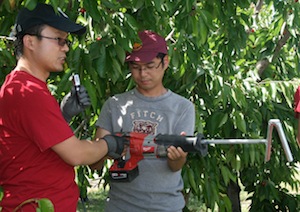Scientists at Washington State University in Prosser are developing technologies for harvesting cherries more efficiently than by hand.
During the annual cherry field day at Prosser last week, graduate students at the Center for Precision and Automated Agricultural Systems (CPAAS) demonstrated their latest version of a handheld, battery-operated vibrating hook, designed to shake the cherries loose from tree limbs, and a handheld catching frame.
The research is part of a four-year $4 million project to develop a highly efficient production, processing, and marketing system for cherries, which was funded by the Specialty Crop Research Initiative. Hand harvesting of sweet cherries accounts for about 60 percent of total production cost.
WSU horticulturist Dr. Matt Whiting, who is project leader, said the handheld devices are designed for use with any type of canopy architecture, whereas a mechanical harvesting machine developed several years ago was best suited to a Y-trellis system. The hook has a variable-sized opening so that it can be used on limbs of different diameters to shake the cherries loose. Both the hook and the catching frame are mounted on poles to eliminate the need for ladders. The catch frame has a flexible tube for transferring the cherries from the catching area into a bucket or bin. It’s expected that pickers would work in teams of two or three, with one picker shaking the cherries off and one or two other pickers catching them and transferring them to harvest containers.
For this type of harvesting, the cherries must detach easily from their stems. Whiting said another aspect of the SCRI project involved screening available cherry varieties for their stem pull force to assess their suitability to mechanical harvesting. WSU has lists of those that are suitable and those that aren’t. Bing needs to be treated with ethephon in order to detach easily from the stem.
WSU scientists have also developed genetic markers for stem retention so that the cherry breeding program can more easily develop new varieties for mechanical harvesting or mechanically assisted methods such as this, Whiting said.



Leave A Comment